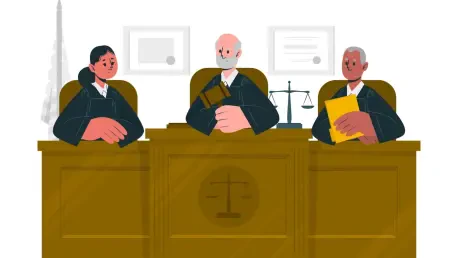In a landmark decision reflecting the ongoing evolution of technology policy in the United States, the Supreme Court has affirmed the validity of the Federal Communications Commission’s (FCC) Universal Service Fund (USF). This decision emphasizes the importance of digital accessibility and equitable distribution of communication resources across the nation. Delivering the verdict by a 6-3 majority, the court addressed the constitutional debates centered around the FCC’s methodology for funding the USF. Central to its deliberations was whether the FCC’s practices violated the non-delegation doctrine, which prohibits Congress from transferring its legislative authority to other entities without clear guidelines. The resolution supports the FCC’s discretion in its approach, thereby securing the future of crucial telecommunications programs that bolster internet and phone services for underserved communities.
The Legal Challenge and Its Implications
Conservative Argument Against FCC’s Approach
The crux of the dispute lay in the FCC’s strategy for gathering contributions to support the USF. Critics, particularly from legal conservative circles, argued that by allowing an independent nonprofit to set funding rates, the FCC was overreaching its authority, a claim rooted in the assertion that the agency defied congressional objectives. This debate questioned the scope of the FCC’s power, contending that it deviated from Congress’s prescribed limitations, thus risking unconstitutional delegation of power. However, Justice Elena Kagan’s majority opinion, which garnered significant attention, highlighted the necessity of such delegation. The opinion emphasized Congress’s intention to grant the FCC enough latitude to adapt to the dynamic landscape of universal communications services, thereby justifying the current funding mechanism involving the Universal Service Administrative Company (USAC).
Majority Opinion and Its Justifications
Justice Kagan elaborated on the legislative intent, underscoring the importance of adaptability in defining universal service amidst technological advancements. Her rationale provided a robust legal basis for the FCC’s delegation, ensuring alignment with evolving societal needs. Under existing law, this approach maintains a balance—equipping the FCC with essential flexibility while embedding safeguards that limit funded services to essential, ubiquitous, and economically viable options. The ruling ensured that these foundational principles continue guiding the FCC’s regulatory scope, consolidating its role as a mediator between technology change and legislative mandates. By supporting a framework that evolves with technology, the decision underscored the court’s recognition of the FCC’s regulatory acumen and its ability to navigate multifaceted communication landscapes, thus cementing its central role in expanding digital access nationwide.
Impact on Broadband Initiatives
Programs Supported by the USF
The ruling’s affirmation of the Universal Service Fund galvanizes several significant broadband initiatives designed to foster connectivity in historically underserved regions. The USF provides structural support for pivotal programs, including the Lifeline and High Cost subsidy programs. These initiatives aim to reduce the financial burdens associated with communications services for low-income families and remote communities. Additionally, the USF sustains the Rural Health Care Program, which is instrumental in enhancing telecommunications services in healthcare facilities located in rural settings, bridging critical access gaps. One prominent beneficiary, the E-Rate program, delivers subsidies aimed at equipping public schools and libraries with access to telecommunications resources. This widespread support not only reinforces educational infrastructure but also underscores the program’s expansive influence on public access to crucial technological capabilities.
Legal Pressure and Its Aftermath
One of the notable challenges to the USF emerged from a lawsuit filed by Consumers’ Research, a conservative nonprofit. Their stance focused on questioning the constitutionality of the mechanisms behind the fund’s establishment and operation. The contention triggered broader legal scrutiny regarding its constitutional validity and set off discussions on the future trajectory of nationwide broadband access. The U.S. Court of Appeals for the Fifth Circuit initially amplified these concerns by challenging the FCC’s discretion, urging a reassessment of oversight and accountability. However, Justice Kagan’s defense of the USF delineated its strategic and statutory relevance, reinforcing that FCC guidelines offer precise methodologies to foster an inclusive communications environment even as broad congressional oversight persists. Ultimately, this legislative rigidity ensured the survivability and growth of foundational broadband services.
The Importance of Technological Equity
Strengthening National Connectivity
The judicial decision has far-reaching implications, reaffirming nearly three decades of concerted legislative and regulatory actions centered on universal service programs. These efforts have consistently fortified national connectivity, endeavoring to align with constitutional doctrines of power separation and organizational competence. By upholding this vital policy framework, the Supreme Court recognized the enduring need for adaptable, inclusive funding mechanisms integral to transforming the nation’s communications landscape. Federal Communications Commission Chairman Brendan Carr praised the ruling, emphasizing the tangible benefits these programs deliver, including bolstering access to future-ready connectivity across diverse demographics. This endorsement facilitated a necessary focus on reforms that refine the FCC’s strategic outlook and ensure it effectively bridges existing connectivity disparities.
Broad Support for Universal Service Programs
The decision drew significant support from various stakeholders, signaling broader acknowledgment of its transformative capacity. U.S. Senator Ed Markey, a vocal proponent of the E-Rate program, expressed relief that funding continuity enables many students to access cutting-edge digital tools essential in contemporary education. He pointedly noted the risks of discontinuing such initiatives, which could detract from educational competitiveness and diminish students’ digital proficiency. Cindy Hohl, representing the American Library Association, extolled the virtues of the decision, particularly in strengthening infrastructure pivotal to comprehensive library services. Since 1996, the E-Rate program has prominently underpinned efforts to modernize public libraries and bolster robust digital offerings. Together, these voices underscored the significance of the Universal Service Fund as a keystone in cultivating equitable media access and societal development.
Future Considerations for Digital Access
Advancing Technological Integration
Through its decision, the Supreme Court highlighted the growing imperative of technological integration across multiple societal sectors. This verdict safeguards the progression toward a more inclusive digital framework, ensuring that transformative technological advancements remain accessible to all demographic groups. The ruling complements ongoing policy endeavors that strive to offer universal service access while simultaneously providing legislative clarity and organizational accountability. It symbolizes a commitment to nurturing an environment where regulation harmonizes with innovation, fostering a resilience that anticipates and adapts to emerging technological challenges.
Bridging the Digital Divide
In its recent decision, the Supreme Court emphasized the essential role of integrating technology across various sectors in society. This ruling is significant as it ensures that the path toward a more inclusive digital environment stays open to all demographic groups. By safeguarding these advancements, the decision supports efforts to make technological progress accessible to everyone, regardless of their background. Moreover, the ruling complements ongoing policy efforts aimed at achieving universal service access. It not only provides much-needed legislative clarity but also emphasizes organizational accountability, paving the way for cohesive development. This decision reflects a dedication to cultivating a balance where regulation and innovation work together harmoniously. Such a framework is crucial for building resilience that can anticipate and adapt to future technological challenges. The ruling serves as a guiding principle, ensuring that policy-making aligns with technological progress and social inclusivity. By doing so, it encourages an environment where innovation can thrive responsibly, benefiting society as a whole.









